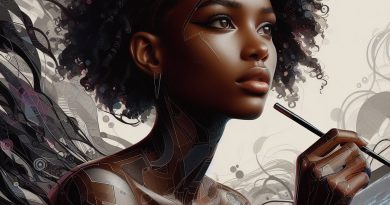Women in Nigerian Art: Celebrating Female Artists
Last Updated on May 26, 2024
Introduction
As we delve into the rich tapestry of Nigerian art, it becomes evident that women play a vital role in shaping its vibrant landscape.
From traditional crafts to contemporary masterpieces, female artists have made significant contributions, enriching the cultural heritage of the nation.
In recent years, there has been a growing awareness of the importance of recognizing and celebrating the achievements of female artists in Nigeria.
This shift in perspective reflects a broader acknowledgment of the need for gender equality and representation across all facets of society, including the arts.
By highlighting the works of female artists, we not only honor their talent and creativity but also challenge outdated stereotypes and biases.
Empowering women in the art world not only benefits individual artists but also contributes to the overall diversity and richness of Nigeria’s artistic expression.
In this blog section, we will explore the multifaceted contributions of female artists to the Nigerian art scene, shedding light on their unique perspectives, talents, and achievements.
Join us as we celebrate the creativity and resilience of women in Nigerian art.
Historical Context
Women have always played a significant role in Nigerian art history.
From the ancient Igbo-Ukwu terracotta and bronze sculptures to contemporary mixed media works, female artists have made notable contributions to the country’s rich artistic landscape.
Prominent Female Artists in Nigerian History
- Ben Enweonwu: Known as the “Father of Nigerian Modernism,” Ben Enweonwu’s daughters, Chinwe and Ifeoma, are also accomplished artists.
- Peju Alatise: A multi-talented artist, Peju Alatise has gained international recognition for her sculpture, painting, and installation works.
- Nike Davies-Okundaye: Renowned for her textile art and promotion of traditional Nigerian weaving techniques, Nike Davies-Okundaye is a pioneer in contemporary African art.
- Njideka Akunyili Crosby: A MacArthur Genius Grant recipient, Njideka Akunyili Crosby’s work blends collage, painting, and printmaking to explore themes of identity and diaspora.
Challenges Faced by Women in the Art World in the Past
- Historically, women artists in Nigeria faced discrimination and limited opportunities for formal training and exhibition.
- Many female artists struggled to balance their artistic pursuits with societal expectations of marriage, motherhood, and domestic responsibilities.
- Female artists often had to navigate a male-dominated art world where their contributions were undervalued and overlooked.
- Access to resources, mentorship, and networking opportunities was harder for women artists compared to their male counterparts.
Despite these challenges, female artists in Nigeria have persevered, using their creativity, resilience, and talent to break barriers and forge paths for future generations of women in the art world.
Read: Communication Arts: Balancing Theory and Practice
Rise of contemporary female artists
Examining themes commonly explored by female artists in Nigeria
Female artists in Nigeria infuse their works with diverse themes, reflecting their unique perspectives and experiences.
Many female artists draw inspiration from personal stories, exploring themes of identity, family, and womanhood in their art.
Identity, in particular, is a recurring theme, with artists grappling with questions of cultural heritage and belonging.
Social issues also feature prominently in the works of female artists, who use art as a tool for activism and advocacy.
Themes such as gender inequality, social justice, and environmental sustainability are common threads in their art.
Sources of inspiration for these artists
Many female artists find inspiration in nature, capturing the beauty of the Nigerian landscape through their art.
History and tradition serve as rich sources of inspiration, with artists reinterpreting traditional motifs and practices in contemporary contexts.
Spirituality and mythology are also prevalent themes, as artists explore the intersection of faith, tradition, and belief systems.
Some artists find inspiration in everyday life, capturing the vibrancy and complexity of Nigerian society through their art.
Overall, the themes explored by female artists in Nigeria are as diverse and varied as the artists themselves.
From personal narratives to universal truths, their art reflects the richness and complexity of the Nigerian experience.
Read: How to Apply for Communication Arts Programs
Themes and Inspirations
Examining themes commonly explored by female artists in Nigeria
- Identity: Female artists in Nigeria often explore themes of identity, both personal and cultural.
- Gender: Many female artists address issues of gender inequality and female empowerment in their work.
- Tradition: Traditional Nigerian culture and customs are frequently depicted in the art of female artists.
- Nature: The beauty of nature, landscapes, and wildlife is a common theme in the works of female artists.
- Social Issues: Female artists in Nigeria highlight social issues such as poverty, corruption, and education through their art.
Sources of inspiration for these artists
- Cultural Heritage: Nigerian female artists draw inspiration from their rich cultural heritage and traditions.
- Personal Experiences: Many female artists use their own life experiences as a source of inspiration for their work.
- Feminism: The feminist movement and gender equality advocacy inspire many female artists in Nigeria.
- Activism: Social and political activism serve as a driving force for many female artists to create meaningful art.
- Nature and Environment: The beauty of the Nigerian landscape and environmental concerns inspire female artists.
Overall, the themes explored by female artists in Nigeria are diverse and deeply rooted in their cultural heritage and personal experiences.
Through their art, these women are able to challenge stereotypes, celebrate their identity, and advocate for social change.
Read: Introduction to African and Asian Studies in Nigeria

Recognition and representation
Addressing the need for increased recognition of female artists in Nigeria
Within the dynamic and culturally rich landscape of Nigerian art, female artists have long been essential contributors, yet their achievements often remain overlooked or underappreciated.
Despite their profound impact on the art scene, many talented female artists continue to face systemic barriers that impede their visibility and recognition.
While Nigeria boasts a thriving artistic community, with artists creating works that reflect the nation’s rich cultural heritage, the representation of female artists in the mainstream art world remains disproportionately low.
This disparity not only deprives these artists of the acknowledgment they deserve but also perpetuates inequalities within the artistic sphere.
As such, addressing the need for increased recognition of female artists is crucial for achieving gender equality and fostering a more inclusive cultural landscape in Nigeria.
Importance of representation in art galleries and museums
Art galleries and museums serve as gatekeepers of culture, curating and exhibiting works that shape our collective understanding of art and society.
Therefore, their role in showcasing the diverse talents of female artists cannot be overstated.
By providing platforms for female artists to exhibit their works, these institutions not only amplify their voices but also challenge traditional gender norms and expand the boundaries of artistic expression.
Representation in galleries and museums is not merely about showcasing individual artworks; it is about validating the experiences, perspectives, and contributions of female artists within the broader narrative of Nigerian art history.
Through exhibitions, retrospectives, and acquisitions, these institutions play a pivotal role in documenting and preserving the cultural legacy of female artists for future generations.
Moreover, the importance of representation extends beyond the walls of galleries and museums.
It sends a powerful message to aspiring female artists that their voices matter and that their contributions to the art world are valued.
By seeing themselves reflected in the art world, young women are inspired to pursue careers in the arts, thus fostering a new generation of creative talent and innovation.
Ultimately, the increased recognition of female artists not only benefits the artists themselves but also enriches the cultural fabric of Nigeria as a whole.
It promotes diversity, gender equality, and social inclusion, fostering a more vibrant and dynamic artistic community.
Therefore, it is imperative that art institutions, collectors, and audiences alike actively support and champion the work of female artists in Nigeria and beyond.
Through collective efforts, we can create a more equitable and inclusive art world that celebrates the diversity of artistic expression.
Read: Famous Nigerian Alumni of Communication Arts Programs
Challenges and Opportunities
The ongoing challenges facing female artists in Nigeria
Within the vibrant and culturally rich landscape of Nigerian art, female artists encounter a myriad of challenges that often hinder their artistic journey and recognition.
Despite their undeniable talent and creative contributions, gender inequality remains a pervasive issue within the Nigerian art community.
Female artists frequently face discrimination and unequal opportunities compared to their male counterparts, making it difficult for them to gain the recognition they deserve.
Moreover, societal expectations and traditional gender roles can constrain the artistic freedom and creative exploration of female artists.
Cultural norms may dictate the subject matter and themes deemed acceptable for women to explore in their artwork, limiting their ability to fully express themselves.
Additionally, many female artists grapple with the dual responsibilities of pursuing their artistic passions while fulfilling familial and caregiving obligations.
Balancing these roles can be immensely challenging and may result in limited time and resources dedicated to artistic endeavors.
Opportunities for growth and empowerment within the art community
Despite these challenges, there are numerous opportunities for female artists to grow, thrive, and assert their presence within the Nigerian art community.
One such opportunity lies in the formation of art collectives and support networks specifically tailored to the needs of female artists.
These platforms provide invaluable resources, mentorship, and networking opportunities, enabling female artists to navigate the complexities of the art world and access new avenues for exposure and recognition.
Collaborative projects and exhibitions also offer fertile ground for female artists to showcase their work and amplify their voices within the artistic community.
By participating in group shows and collaborative ventures, female artists can forge meaningful connections, expand their audience reach, and garner critical acclaim for their artistic endeavors.
Furthermore, art education and training programs play a pivotal role in empowering female artists and equipping them with the skills, knowledge, and confidence needed to succeed in the competitive art market.
Access to quality art education enables female artists to refine their craft, experiment with new techniques, and develop their unique artistic voice.
In addition to individual growth and development, initiatives aimed at promoting gender equality and diversity within the art community have the potential to create a more inclusive and supportive environment for female artists.
By advocating for greater representation and recognition of female artists, the art community can work towards breaking down systemic barriers and fostering a culture of equality and respect.
Ultimately, by seizing these opportunities for growth and empowerment, female artists in Nigeria can overcome challenges, assert their artistic identities, and contribute meaningfully to the vibrant and diverse tapestry of Nigerian art.
Through collective efforts and unwavering determination, the Nigerian art community can strive towards creating a more equitable, inclusive, and supportive environment where all artists, regardless of gender, can thrive and flourish.
Conclusion
Reflecting on the contributions of female artists to Nigerian art, it is evident that they have brought unique perspectives and creativity to the art scene.
Their works often tackle important social issues, showcase the beauty of Nigerian culture, and challenge traditional norms.
Female artists in Nigeria have made significant strides in breaking barriers and gaining recognition for their talents.
Moving forward, it is important to continue supporting and celebrating female artists in Nigeria.
By providing opportunities for them to exhibit their work, collaborate with others, and receive fair compensation, we can help elevate their voices and contributions.
It is crucial for the art community and society as a whole to recognize the valuable role that female artists play in shaping the cultural landscape of Nigeria.
By championing gender equality and diversity in the arts, we can foster a more inclusive and vibrant artistic community.
Let us all commit to promoting and uplifting female artists in Nigeria, ensuring that their talents and perspectives are not only acknowledged but also celebrated.
Together, we can create a more equitable and empowering environment for women in the arts.


